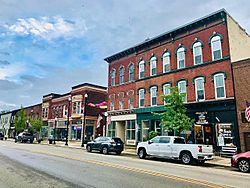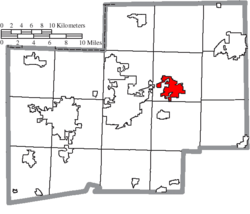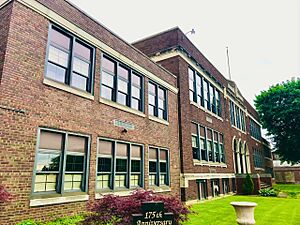Louisville, Ohio facts for kids
Quick facts for kids
Louisville, Ohio
|
|
|---|---|

Downtown Louisville
|
|
| Nickname(s):
"The Constitution Town"
|
|

Location of Louisville in Stark County
|
|
| Country | United States |
| State | Ohio |
| County | Stark |
| Area | |
| • Total | 5.70 sq mi (14.76 km2) |
| • Land | 5.70 sq mi (14.76 km2) |
| • Water | 0.00 sq mi (0.00 km2) |
| Elevation | 1,099 ft (335 m) |
| Population
(2020)
|
|
| • Total | 9,521 |
| • Density | 1,670.35/sq mi (644.90/km2) |
| Time zone | UTC−5 (Eastern (EST)) |
| • Summer (DST) | UTC−4 (EDT) |
| ZIP code |
44641
|
| Area code | 330 |
| FIPS code | 39-45094 |
| GNIS feature ID | 1086980 |
| Website | Louisville, Ohio |
Louisville is a city in Stark County, Ohio, USA. In 2020, about 9,521 people lived there. It is located about 7 miles northeast of Canton. Louisville is a suburb in the larger Canton–Massillon metropolitan area.
Contents
History of Louisville, Ohio
Louisville was officially started on October 8, 1834. Henry Lautzenheiser from Germany and Henry Fainot from France were its founders. The city was named after Lautzenheiser's son, Lewis. It was first called Lewisville, Ohio.
When the post office opened in 1837, another town in Ohio was already named Lewisville. So, the spelling was changed to Louisville. Sam Petree was the first postmaster.
Early Growth and Competition
In its early days, Louisville competed with a nearby town called Harrisburg. Harrisburg was a popular stop for stagecoaches. These coaches traveled between cities like Canton, Alliance, Cleveland, and Pittsburgh.
Louisville also grew because it was located on the east branch of the Nimishillen Creek. This creek flows towards Canton. In 1852, the Pittsburgh, Fort Wayne and Chicago Railway was built through Louisville. This helped Louisville grow much faster than Harrisburg. Today, Harrisburg is a small, unincorporated community.
Becoming a Village and City
On April 1, 1872, Louisville officially became a village. George Violand was elected as its first mayor. By the late 1800s, Louisville had many growing businesses. These included a plow factory, a wooden mill, and flour mills. There were also hotels, a shoe factory, and many taverns.
Some of these old businesses, like Star Mill and the Town Tavern, are still open today. Many historic buildings from this time are on the National Register of Historic Places. This includes Saint Louis Catholic Church, built in 1870. The city's newspaper, The Louisville Herald, started in 1887.
For a short time, Louisville had a Roman Catholic college. It was called Saint Louis College and opened in 1866. It closed in 1873 due to money problems and travel difficulties for students. Later, the building became an orphanage and then a hospice for the elderly. The old building was taken down in 1975. A McDonald's restaurant is now on that spot.
In the early 1880s, telephone lines came to Louisville. The first public street lights were lit downtown for Christmas in 1884. A public water system was set up in 1894. A sewage system followed in 1910. Main Street became the first paved road in 1914. In 1960, Louisville's residents voted for the village to become a city.
The Constitution Town
Louisville is known as the "Constitution Town." This is because a resident named Olga T. Weber worked hard to create Constitution Day in the USA. In 1952, her efforts led the Ohio General Assembly to make September 17 a statewide "Constitution Day."
The next year, Olga Weber asked the United States Senate to declare September 17–23 as "Constitution Week." Both the Senate and the United States House of Representatives approved her request. President Dwight D. Eisenhower signed it into law. On April 15, 1957, Louisville's City Council officially named itself "The Constitution Town." The city still celebrates "Constitution Week" every year in September.
Geography
The east branch of Nimishillen Creek flows through Louisville. The city covers about 5.49 square miles (14.22 square kilometers) of land.
Population and People
| Historical population | |||
|---|---|---|---|
| Census | Pop. | %± | |
| 1880 | 1,650 | — | |
| 1890 | 1,323 | −19.8% | |
| 1900 | 1,374 | 3.9% | |
| 1910 | 1,678 | 22.1% | |
| 1920 | 2,008 | 19.7% | |
| 1930 | 3,130 | 55.9% | |
| 1940 | 3,379 | 8.0% | |
| 1950 | 3,801 | 12.5% | |
| 1960 | 5,116 | 34.6% | |
| 1970 | 6,298 | 23.1% | |
| 1980 | 7,996 | 27.0% | |
| 1990 | 8,087 | 1.1% | |
| 2000 | 8,904 | 10.1% | |
| 2010 | 9,186 | 3.2% | |
| 2020 | 9,521 | 3.6% | |
| Sources: | |||
2010 Census Information
In 2010, Louisville had 9,186 people living in 3,727 households. About 2,498 of these were families. The city had about 1,673 people per square mile.
Most residents (98.3%) were White. About 1.3% of the population was Hispanic or Latino.
About 33.9% of households had children under 18. Nearly half (49.4%) were married couples. The average household had 2.44 people. The average family had 2.99 people.
The average age in the city was 39.4 years. About 25.4% of residents were under 18. About 18% were 65 or older. The city was 46.5% male and 53.5% female.
Education
Public Schools
The Louisville City School District serves Louisville and the surrounding area. It includes:
- Louisville High School
- Louisville Middle School
- Louisville Elementary School
- North Nimishillen Elementary School
Private Schools
Louisville also has private schools. These include St. Thomas Aquinas High School/Middle School. The Holy Cross Academy at Saint Louis Campus is also in the city.
Saint Louis School opened in 1852. It closed after the 2018–2019 school year. St. Thomas Aquinas High School opened in 1964. In 2014, it added a Middle School program for grades 6–8.
Notable People
- Joseph Gabriel Harner: A US Navy member who received the Medal of Honor.
- Augustus D. Juilliard: A generous person who supported good causes. The Juilliard Arts Center in Louisville is named after him.
- Edward Julien Moinet: A judge for the United States Federal Court.
- Pat Rebillot: A talented jazz pianist.
- Olga T. Weber: An activist who helped establish Constitution Day and Constitution Week in Ohio and the United States.
See also
 In Spanish: Louisville (Ohio) para niños
In Spanish: Louisville (Ohio) para niños





